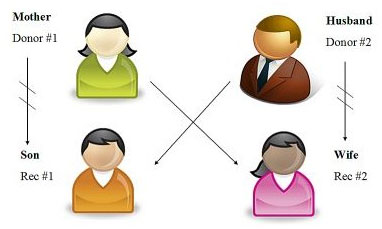Kidney paired exchange
What is kidney paired exchange (KPE)?
Kidney paired exchange (KPE) connects people who need kidney transplants with matching donors. If you volunteer to donate your kidney, you may not match the person you want to donate to because of your blood type or other factors. But that doesn’t mean you can’t help.
KPE can help you find people in the same situation that are a good match, then you can swap with them so both patients can get a kidney.
How does kidney paired exchange (KPE) work?
Let’s look at an example:

- Pat needs a kidney transplant, and Ronald wants to donate one of his kidneys to Pat. But after testing, the doctors find that Ronald isn’t a good match for Pat.
- Pat and Ronald decide to sign up for a KPE program, and that’s how they find Jennifer and Michael.
- Jennifer needs a kidney and her friend Michael wants to donate, but Michael isn’t a good match for Jennifer.
- Through the KPE program, these two pairs find out that Michael is a good match for Pat and Ronald is a good match for Jennifer.
- So these two pairs exchange, and both Pat and Jennifer are able to get the kidney transplants they need.
Learn more about how this works at:
https://www.unos.org/donation/kidney-paired-donation/
KPE has made it possible for hundreds of people to get a kidney transplant who might not have been able to. Transplant centers across the country are connecting pairs of people who aren’t a good match with other pairs of people who are a good match.
How (KPE) works at your center
If you and the person you want to donate to aren’t a good match but you still want to donate, talk with your transplant center about the KPE program. If you decide to sign up, your transplant center will:
- Require you to sign another consent form for the KPE program
- Enter your information into a KPE database
- Teach you about the KPE program
- Help you learn what to expect from the KPE process
- Describe different options for paired exchange, and help you decide what arrangements feel OK for you
If the KPE program finds a pair for you to match with, your transplant center will coordinate the transplant surgeries. Here are some things to remember:
- Sometimes the KPE program can find you a match quickly, but sometimes it takes weeks or months
- Usually, you and the person you wanted to donate to will have surgeries at similar times, but sometimes one surgery happens later than the other
- You will almost always have your surgery at the transplant center where you did your evaluation and testing
- Sometimes more than 2 pairs are needed to find a good match for everyone, which is called a chain.
If your transplant center doesn’t participate in a KPE program, you can ask them to refer you to a transplant center that does.
What are the risks of kidney paired exchange (KPE)?
The kidney donation procedure itself is the same for you as it would have been if you had been able to donate directly:
- You can still have surgery at your original center
- Your hospitalization and recovery are the same
- Risks to the transplant recipient are similar
Some risks of KPE are different than if you donate directly to the person you know:
- Worry while you wait for a match
- Potential for more blood draws, as possible matches are explored
- Sadness or depression if the KPE process doesn’t work out
- Different financial costs (Ask your transplant center to double check that your coverage will be the same).
- A very small chance that your kidney could become unable to be transplanted during the shipping process

Note: This information is the opinion of the Living Donor Community of Practice (LDCOP) of the American Society of Transplantation. The LDCOP is a group of health care professionals and researchers who specialize in living kidney donation. The LDCOP’s recommendations are meant to offer you helpful information, but you may find opinions from other groups or organizations that are helpful to you, too.

